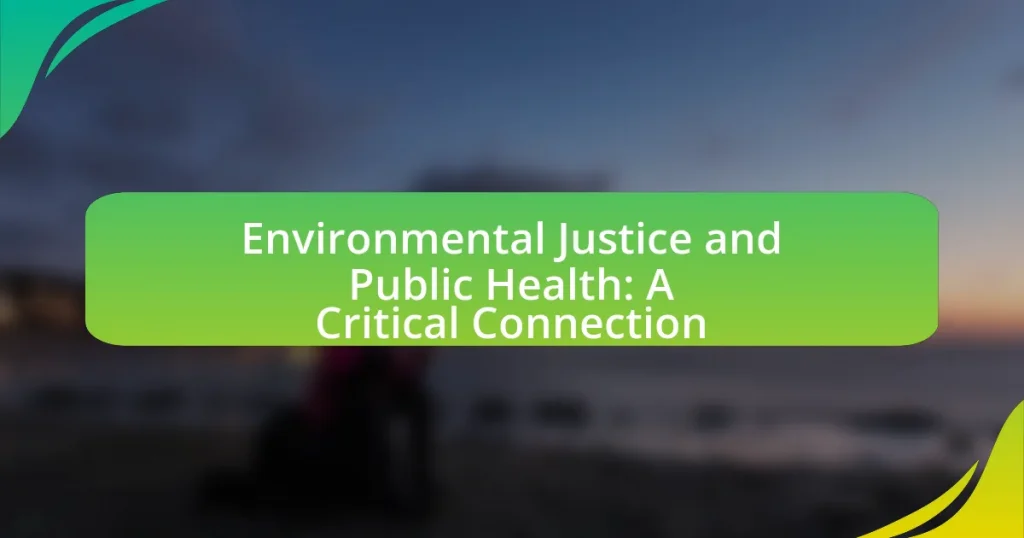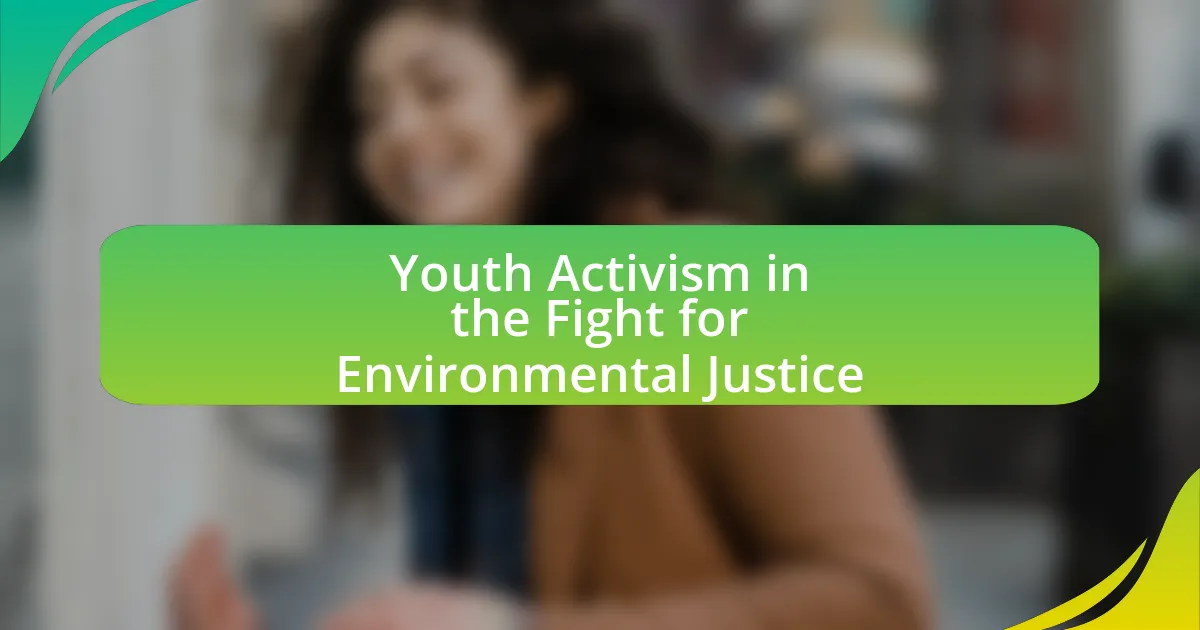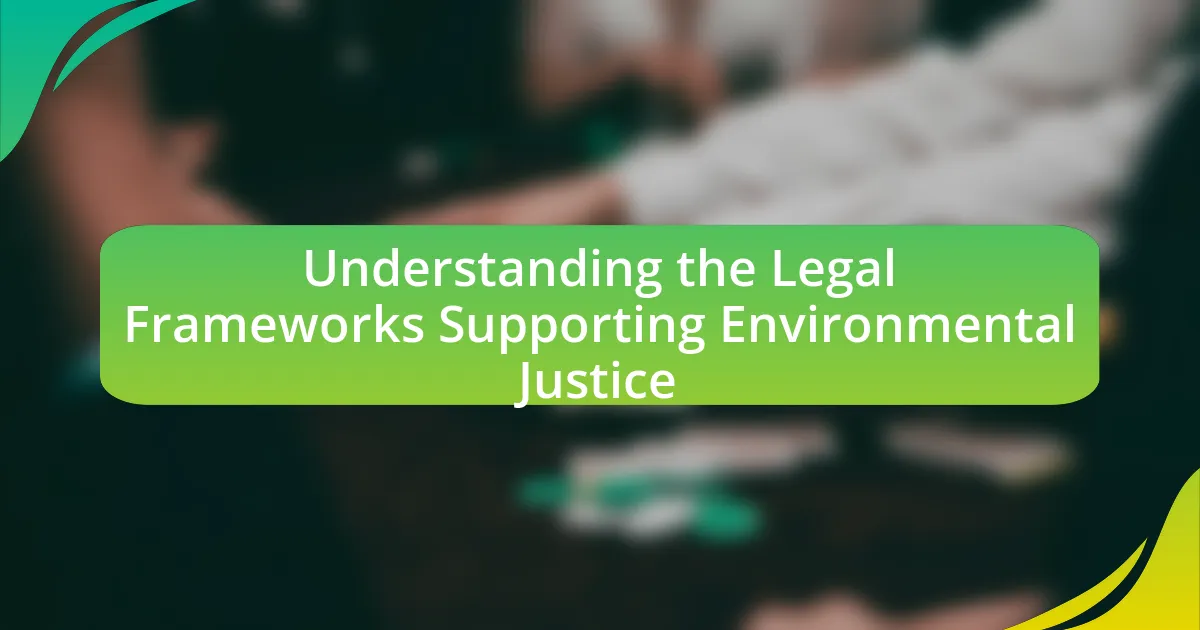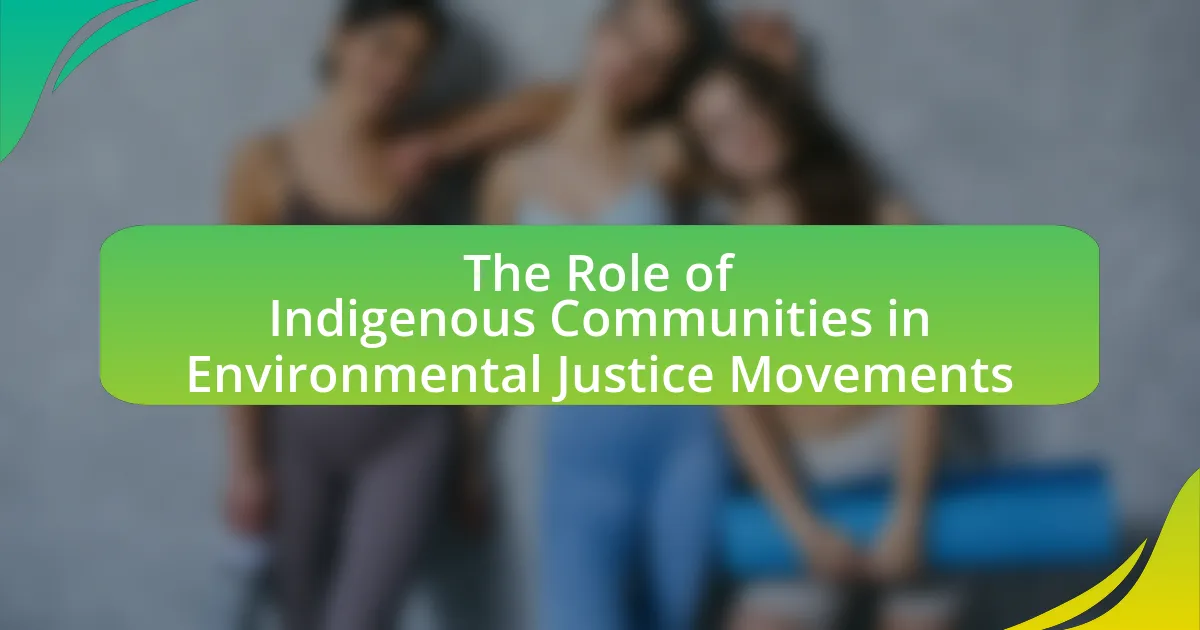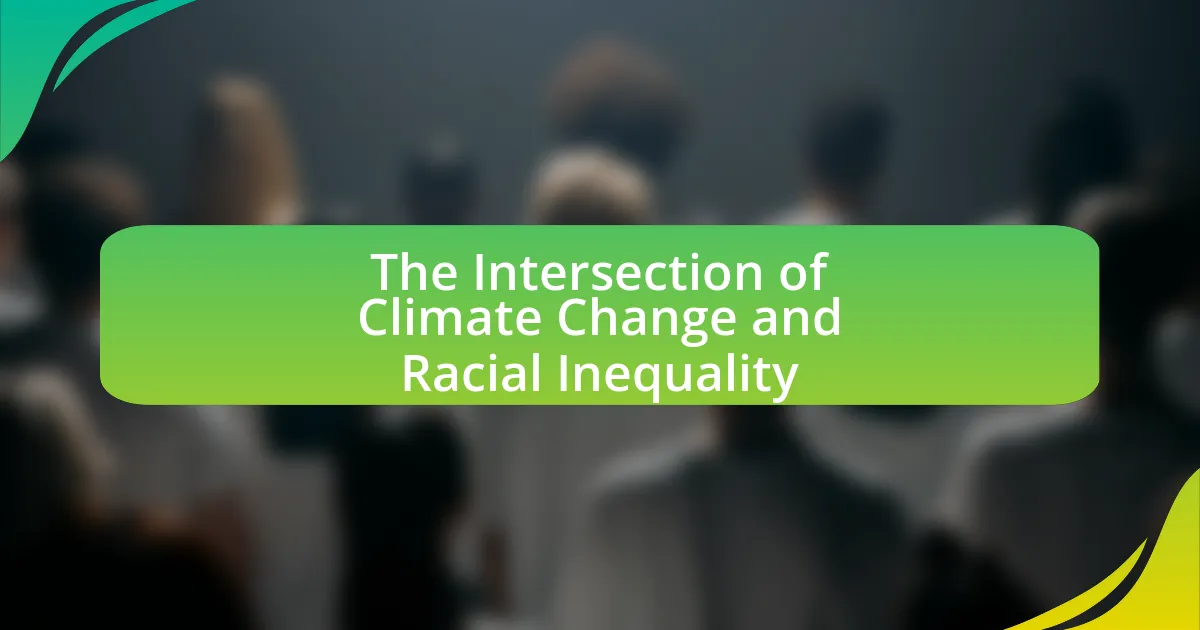Environmental justice is the equitable distribution of environmental benefits and burdens across all communities, particularly focusing on marginalized populations that face disproportionate environmental hazards. This article explores the critical connection between environmental justice and public health, highlighting how environmental factors such as pollution directly impact health outcomes, especially in low-income and minority communities. It examines historical events that have shaped this relationship, the socio-economic factors influencing health disparities, and the importance of community engagement and policy changes in promoting environmental justice. Additionally, the article discusses the challenges faced in achieving environmental justice and the role of health professionals in advocating for equitable health outcomes.
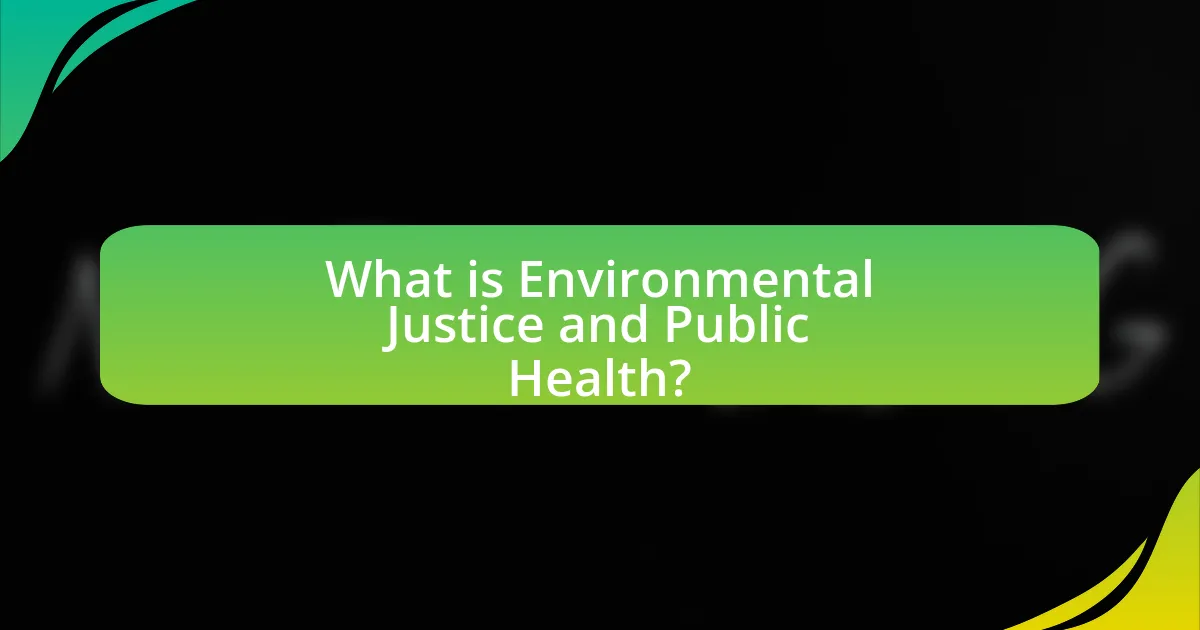
What is Environmental Justice and Public Health?
Environmental justice refers to the equitable distribution of environmental benefits and burdens across all communities, ensuring that no group, particularly marginalized populations, faces disproportionate environmental hazards. Public health is the science of protecting and improving the health of people and their communities through education, policy-making, and research for disease and injury prevention. The intersection of environmental justice and public health highlights how environmental factors, such as pollution and access to clean resources, directly impact community health outcomes. Studies have shown that low-income and minority communities often experience higher exposure to environmental toxins, leading to increased health risks, such as respiratory diseases and other chronic conditions. This connection underscores the importance of addressing environmental disparities to promote overall public health and well-being.
How are Environmental Justice and Public Health interconnected?
Environmental Justice and Public Health are interconnected through the impact of environmental factors on health outcomes, particularly for marginalized communities. Environmental Justice addresses the disproportionate exposure of low-income and minority populations to environmental hazards, such as pollution and toxic waste, which directly affects their health. For instance, studies show that communities near industrial sites often experience higher rates of respiratory diseases and other health issues due to air and water pollution. This correlation highlights the necessity of integrating public health initiatives with environmental policies to ensure equitable health outcomes for all populations.
What historical events have shaped the relationship between Environmental Justice and Public Health?
The relationship between Environmental Justice and Public Health has been significantly shaped by events such as the Civil Rights Movement, the establishment of the Environmental Protection Agency (EPA) in 1970, and the 1982 protests in Warren County, North Carolina. The Civil Rights Movement highlighted systemic inequalities, leading to increased awareness of how environmental hazards disproportionately affect marginalized communities. The creation of the EPA marked a pivotal moment in environmental regulation, emphasizing the need for public health considerations in environmental policies. The protests in Warren County against the siting of a hazardous waste landfill underscored the intersection of environmental racism and public health, catalyzing the Environmental Justice movement and leading to the 1994 Executive Order 12898, which aimed to address environmental justice in federal agencies. These events collectively illustrate the evolving understanding of how environmental factors impact public health, particularly for vulnerable populations.
How do socio-economic factors influence this connection?
Socio-economic factors significantly influence the connection between environmental justice and public health by determining access to resources, exposure to environmental hazards, and overall health outcomes. Individuals in lower socio-economic groups often reside in areas with higher pollution levels, limited access to healthcare, and inadequate infrastructure, which exacerbates health disparities. For instance, research indicates that communities with lower income levels are more likely to be situated near industrial sites, leading to increased exposure to toxic substances and higher rates of respiratory diseases. Additionally, socio-economic status affects educational opportunities, which in turn influences awareness and advocacy for environmental health issues, further entrenching inequalities.
Why is Environmental Justice important for Public Health?
Environmental Justice is crucial for Public Health because it addresses the disproportionate environmental burdens faced by marginalized communities, which directly impact their health outcomes. Research indicates that low-income and minority populations often experience higher exposure to pollutants and hazardous waste, leading to increased rates of respiratory diseases, cancer, and other health issues. For instance, a study published in the American Journal of Public Health found that communities of color are more likely to live near industrial sites, resulting in elevated health risks. By promoting Environmental Justice, we can ensure equitable access to clean air, water, and safe living conditions, ultimately improving public health for all populations.
What are the health disparities linked to environmental injustices?
Health disparities linked to environmental injustices include increased rates of respiratory diseases, cardiovascular conditions, and higher incidences of certain cancers among marginalized communities. These disparities arise from disproportionate exposure to pollutants, toxic waste, and inadequate access to healthcare services. For instance, studies show that low-income neighborhoods and communities of color often face higher levels of air and water pollution, leading to significant health risks. According to the Environmental Protection Agency, people living in these areas are more likely to suffer from asthma and other chronic illnesses due to environmental hazards, highlighting the critical connection between environmental justice and public health.
How does pollution impact vulnerable communities?
Pollution significantly impacts vulnerable communities by exacerbating health disparities and environmental injustices. These communities often face higher exposure to pollutants due to their proximity to industrial sites, highways, and waste disposal areas. For instance, studies show that low-income neighborhoods and communities of color are more likely to be located near sources of air and water pollution, leading to increased rates of respiratory diseases, cardiovascular issues, and other health problems. According to the Environmental Protection Agency, people living in these areas are 2 to 3 times more likely to suffer from health issues related to pollution compared to those in affluent neighborhoods. This disproportionate burden highlights the critical connection between environmental justice and public health, as systemic inequities in resource allocation and regulatory enforcement further compound the negative effects of pollution on these vulnerable populations.
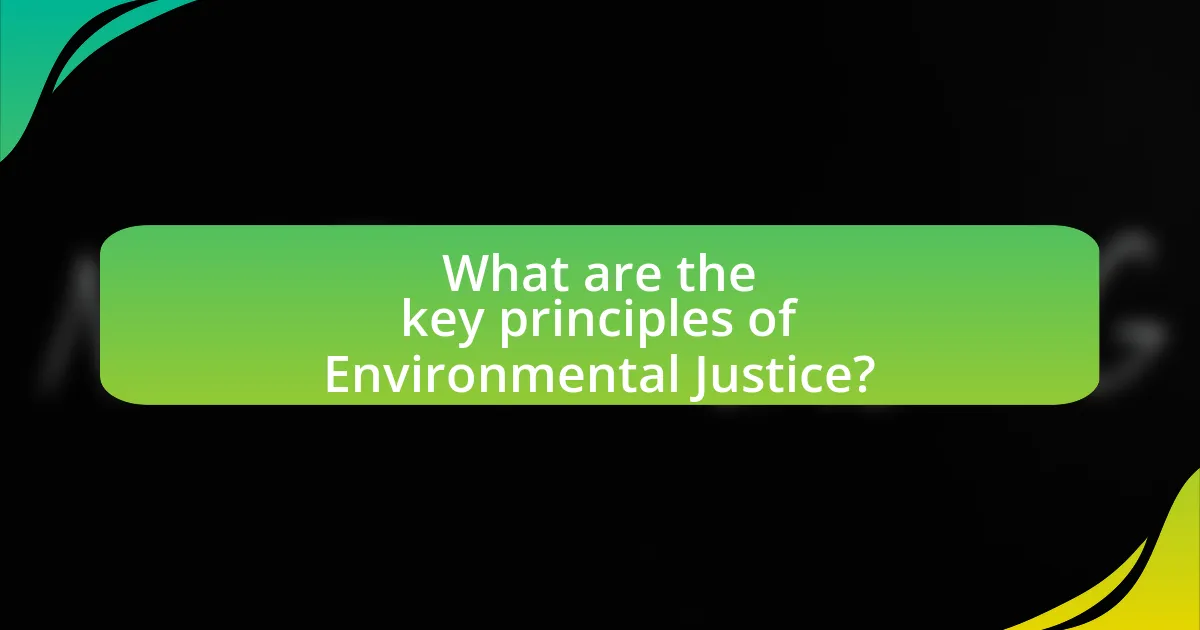
What are the key principles of Environmental Justice?
The key principles of Environmental Justice include the fair treatment and meaningful involvement of all people, regardless of race, color, national origin, or income, in environmental decision-making processes. This principle emphasizes that no group should bear a disproportionate share of negative environmental consequences, ensuring equitable access to a healthy environment. Additionally, it advocates for the right to participate in the development, implementation, and enforcement of environmental laws and policies. The United States Environmental Protection Agency recognizes these principles as essential for addressing environmental disparities and promoting public health equity.
How do these principles apply to Public Health initiatives?
The principles of environmental justice apply to public health initiatives by ensuring equitable access to health resources and addressing the disproportionate impact of environmental hazards on marginalized communities. Public health initiatives that incorporate these principles actively seek to identify and mitigate health disparities caused by environmental factors, such as pollution and lack of access to clean water. For instance, the U.S. Environmental Protection Agency’s Environmental Justice Strategy emphasizes community engagement and the inclusion of affected populations in decision-making processes, which has been shown to improve health outcomes in vulnerable communities. This approach is supported by research indicating that communities involved in environmental decision-making experience better health results, as seen in the case of the Community Action for a Renewed Environment program, which led to significant reductions in toxic exposures in participating neighborhoods.
What role do community engagement and participation play?
Community engagement and participation are essential for addressing environmental justice and public health issues. They empower communities to voice their concerns, influence decision-making, and ensure that policies reflect their needs. Research indicates that when communities actively participate, there is a higher likelihood of successful implementation of health initiatives, as seen in the 2018 study by the American Public Health Association, which found that community-led interventions significantly improved health outcomes in marginalized populations. This active involvement fosters trust, enhances transparency, and leads to more equitable health solutions, ultimately bridging the gap between environmental justice and public health.
How can policy changes promote Environmental Justice in Public Health?
Policy changes can promote Environmental Justice in Public Health by ensuring equitable access to clean air, water, and safe living conditions for marginalized communities. For instance, implementing stricter regulations on industrial emissions can reduce pollution in low-income neighborhoods, which often bear the brunt of environmental hazards. Research from the Environmental Protection Agency indicates that communities of color are disproportionately affected by air pollution, leading to higher rates of respiratory diseases. By prioritizing these communities in policy frameworks, such as the Biden Administration’s Justice40 Initiative, which aims to direct 40% of climate and clean energy investments to disadvantaged communities, public health outcomes can improve significantly. This approach not only addresses environmental disparities but also fosters community engagement and empowerment in health-related decision-making processes.
What are the challenges in achieving Environmental Justice?
Achieving Environmental Justice faces several challenges, including systemic inequality, lack of political representation, and inadequate access to resources. Systemic inequality often results in marginalized communities bearing a disproportionate burden of environmental hazards, such as pollution and toxic waste. For instance, studies show that low-income and minority populations are more likely to live near hazardous waste sites, which exacerbates health disparities. Additionally, these communities frequently lack political representation, limiting their ability to influence environmental policies that affect their lives. Furthermore, inadequate access to resources, such as legal support and information, hinders their capacity to advocate for their rights and seek redress. These interconnected challenges create significant barriers to achieving equitable environmental outcomes.
What barriers do marginalized communities face in accessing health resources?
Marginalized communities face significant barriers in accessing health resources, primarily due to socioeconomic factors, systemic discrimination, and geographic isolation. Socioeconomic factors include lower income levels, which limit access to quality healthcare services and insurance coverage; for instance, according to the U.S. Census Bureau, individuals in poverty are more likely to forgo necessary medical care due to cost. Systemic discrimination manifests in healthcare settings, where biases can lead to inadequate treatment and mistrust between providers and patients; studies show that racial and ethnic minorities often receive lower-quality care compared to their white counterparts. Geographic isolation further exacerbates these issues, as many marginalized communities reside in areas with fewer healthcare facilities, making it difficult to obtain timely medical attention; the Health Resources and Services Administration reports that rural areas often lack adequate healthcare infrastructure. These interconnected barriers create a cycle of health inequity that disproportionately affects marginalized populations.
How does systemic inequality affect environmental health outcomes?
Systemic inequality adversely affects environmental health outcomes by disproportionately exposing marginalized communities to environmental hazards. Research indicates that low-income and minority populations often reside in areas with higher levels of pollution, inadequate access to clean water, and limited healthcare resources. For instance, a study published in the American Journal of Public Health found that communities of color are more likely to be located near hazardous waste sites, leading to increased rates of respiratory diseases and other health issues. This correlation highlights how systemic factors, such as socioeconomic status and racial discrimination, contribute to unequal environmental health risks, ultimately exacerbating health disparities among vulnerable populations.
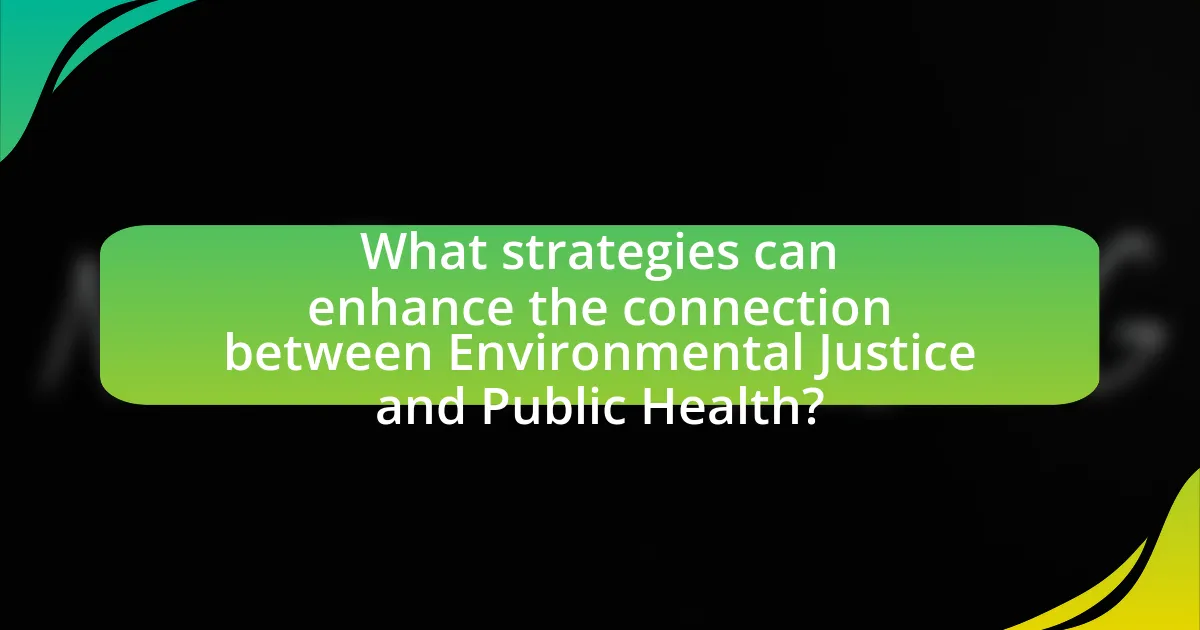
What strategies can enhance the connection between Environmental Justice and Public Health?
Strategies that can enhance the connection between Environmental Justice and Public Health include integrating community engagement in policy-making, promoting equitable access to health resources, and implementing comprehensive environmental assessments. Community engagement ensures that marginalized populations have a voice in decisions affecting their environment and health, which is supported by studies showing that participatory approaches lead to better health outcomes. Equitable access to health resources addresses disparities in healthcare availability, as evidenced by research indicating that communities with higher environmental burdens often face greater health risks. Comprehensive environmental assessments identify and mitigate risks in vulnerable communities, aligning with findings that highlight the correlation between environmental hazards and public health issues.
How can public policies be designed to support this connection?
Public policies can be designed to support the connection between environmental justice and public health by integrating health impact assessments into environmental regulations. This approach ensures that potential health outcomes are considered when making decisions about land use, pollution control, and resource allocation. For instance, the National Environmental Policy Act mandates federal agencies to assess the environmental and health impacts of their actions, which has led to more informed decision-making that prioritizes vulnerable communities. Additionally, policies can promote equitable access to clean air and water by enforcing stricter pollution controls in marginalized areas, as evidenced by the Environmental Protection Agency’s initiatives aimed at reducing environmental hazards in low-income neighborhoods. These strategies collectively enhance public health outcomes while addressing systemic inequalities in environmental exposure.
What role do health professionals play in advocating for Environmental Justice?
Health professionals play a crucial role in advocating for Environmental Justice by addressing the health disparities caused by environmental hazards. They assess the impact of pollution and climate change on vulnerable populations, providing evidence-based recommendations to policymakers. For instance, the American Public Health Association emphasizes that health professionals can influence legislation by highlighting the links between environmental conditions and public health outcomes, such as increased rates of asthma in communities near industrial sites. Their expertise allows them to educate communities about environmental risks and promote equitable access to clean air, water, and safe living conditions, thereby fostering healthier environments for all.
How can education and awareness campaigns improve community health?
Education and awareness campaigns can significantly improve community health by providing individuals with essential knowledge about health risks and preventive measures. These campaigns empower communities to make informed decisions regarding their health, leading to healthier behaviors and lifestyle changes. For instance, a study published in the American Journal of Public Health found that communities exposed to health education initiatives saw a 25% increase in vaccination rates and a 30% reduction in smoking prevalence. By disseminating information on topics such as nutrition, exercise, and disease prevention, these campaigns foster a culture of health awareness, ultimately reducing the incidence of chronic diseases and improving overall community well-being.
What best practices can be implemented for effective Environmental Justice initiatives?
Effective Environmental Justice initiatives can be implemented through community engagement, equitable policy-making, and data-driven decision-making. Community engagement ensures that marginalized voices are included in the planning and implementation processes, fostering trust and collaboration. Equitable policy-making involves creating regulations that specifically address the needs of disadvantaged communities, ensuring that they receive fair treatment and protection from environmental hazards. Data-driven decision-making relies on accurate data collection and analysis to identify environmental risks and health disparities, enabling targeted interventions. For instance, the U.S. Environmental Protection Agency’s Environmental Justice Strategy emphasizes these practices to address the disproportionate impact of environmental issues on low-income and minority populations, demonstrating their effectiveness in promoting health equity.
How can collaboration between organizations enhance outcomes?
Collaboration between organizations can enhance outcomes by pooling resources, expertise, and networks to address complex issues more effectively. For instance, partnerships between public health agencies and environmental organizations can lead to comprehensive strategies that tackle both health disparities and environmental hazards. Research shows that collaborative efforts, such as the partnership between the Centers for Disease Control and Prevention and local health departments, have resulted in improved health outcomes through shared data and coordinated interventions. This synergy not only maximizes impact but also fosters innovation, as diverse perspectives contribute to more holistic solutions.
What metrics can be used to measure success in Environmental Justice efforts?
Metrics used to measure success in Environmental Justice efforts include health outcomes, community engagement levels, and environmental quality indicators. Health outcomes can be assessed through statistics on disease prevalence, mortality rates, and access to healthcare services in marginalized communities. Community engagement levels can be evaluated by tracking participation in public meetings, surveys, and feedback mechanisms that reflect community input in decision-making processes. Environmental quality indicators encompass measurements of air and water pollution levels, access to green spaces, and compliance with environmental regulations, which can be quantified through data from environmental monitoring agencies. These metrics collectively provide a comprehensive view of the effectiveness of Environmental Justice initiatives.
What practical steps can individuals take to promote Environmental Justice in their communities?
Individuals can promote Environmental Justice in their communities by engaging in local advocacy efforts, such as participating in town hall meetings to voice concerns about environmental issues affecting marginalized populations. This engagement is crucial as studies show that communities with active participation can influence policy changes that address environmental disparities. Additionally, individuals can support local organizations focused on environmental justice, which often work to raise awareness and provide resources for affected communities. Research indicates that grassroots movements have successfully led to significant improvements in environmental policies, demonstrating the power of collective action. Furthermore, educating oneself and others about environmental issues, particularly those impacting vulnerable groups, fosters a more informed community that can advocate for equitable solutions.
